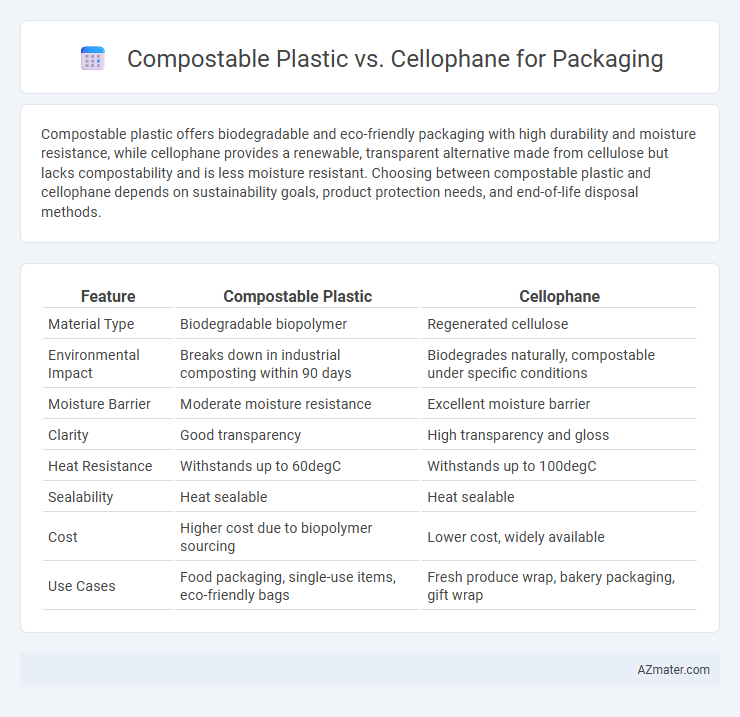Compostable plastic offers biodegradable and eco-friendly packaging with high durability and moisture resistance, while cellophane provides a renewable, transparent alternative made from cellulose but lacks compostability and is less moisture resistant. Choosing between compostable plastic and cellophane depends on sustainability goals, product protection needs, and end-of-life disposal methods.
Table of Comparison
| Feature | Compostable Plastic | Cellophane |
|---|---|---|
| Material Type | Biodegradable biopolymer | Regenerated cellulose |
| Environmental Impact | Breaks down in industrial composting within 90 days | Biodegrades naturally, compostable under specific conditions |
| Moisture Barrier | Moderate moisture resistance | Excellent moisture barrier |
| Clarity | Good transparency | High transparency and gloss |
| Heat Resistance | Withstands up to 60degC | Withstands up to 100degC |
| Sealability | Heat sealable | Heat sealable |
| Cost | Higher cost due to biopolymer sourcing | Lower cost, widely available |
| Use Cases | Food packaging, single-use items, eco-friendly bags | Fresh produce wrap, bakery packaging, gift wrap |
Introduction to Sustainable Packaging Solutions
Compostable plastic and cellophane represent key innovations in sustainable packaging solutions, each offering distinct environmental benefits. Compostable plastics are designed to break down organically within industrial composting environments, reducing landfill waste and greenhouse gas emissions. Cellophane, derived from cellulose, is biodegradable and allows for excellent moisture and air permeability, making it a renewable alternative to conventional plastics in packaging applications.
Overview of Compostable Plastics
Compostable plastics are derived from renewable biomass sources such as cornstarch, sugarcane, and cellulose, designed to break down into natural elements under industrial composting conditions within a specific timeframe. Unlike conventional plastics, compostable plastics comply with standards like ASTM D6400 or EN 13432, ensuring biodegradability without leaving toxic residues. This eco-friendly packaging alternative reduces landfill waste and minimizes the environmental footprint compared to materials like cellophane, which, although biodegradable, does not always meet compostability criteria.
What is Cellophane?
Cellophane is a thin, transparent film made from regenerated cellulose derived from wood pulp or cotton fibers, widely used in packaging due to its biodegradability and excellent moisture barrier properties. Unlike compostable plastics, which are typically petroleum-based biopolymers designed to break down in industrial composting conditions, cellophane naturally decomposes in the environment without releasing harmful toxins. Its renewable source and ability to maintain product freshness make cellophane a sustainable alternative for eco-friendly packaging solutions.
Raw Materials: Origins and Sourcing
Compostable plastic is typically derived from renewable biomass sources such as corn starch, sugarcane, or potato starch, emphasizing sustainable agricultural origins that promote reduced reliance on fossil fuels. Cellophane, on the other hand, is made from cellulose extracted from wood pulp sourced primarily from sustainably managed forests, ensuring a natural and biodegradable packaging material. Both materials prioritize renewable raw materials but differ in their supply chains, with compostable plastics relying heavily on crop-based inputs and cellophane utilizing lignocellulosic fiber from timber.
Compostability and Decomposition Rates
Compostable plastic is designed to break down within industrial composting facilities, typically decomposing in 90 to 180 days under controlled heat and humidity conditions. Cellophane, made from cellulose derived from wood pulp, naturally biodegrades in soil and water environments but generally requires a longer time frame, often taking several months to a year. The faster decomposition rates of compostable plastics in certified composting environments make them a preferred choice for reducing long-term packaging waste compared to cellophane's slower, natural breakdown process.
Environmental Impact Assessment
Compostable plastic packaging, derived from renewable resources like cornstarch, offers faster biodegradation compared to traditional cellophane, reducing landfill accumulation and greenhouse gas emissions. Cellophane, made from cellulose, is biodegradable but can take longer to decompose unless industrial composting conditions are met, potentially limiting its environmental benefits. Life-cycle assessments highlight that compostable plastics typically have a lower carbon footprint and reduced toxicity during disposal, making them a more sustainable choice in eco-friendly packaging solutions.
Barrier Properties and Packaging Performance
Compostable plastic offers superior moisture and oxygen barrier properties compared to cellophane, enhancing shelf life and maintaining product freshness in packaging applications. Cellophane provides moderate barrier performance with excellent breathability, making it suitable for packaging items that require moisture vapor transmission, such as produce and baked goods. Packaging performance of compostable plastics aligns well with sustainability goals, combining durability with biodegradability, whereas cellophane offers a natural, renewable alternative with limited resistance to water vapor and oxygen.
Applications in Food and Retail Packaging
Compostable plastic offers biodegradable packaging solutions ideal for fresh produce, bakery items, and ready-to-eat meals, reducing environmental impact significantly compared to traditional plastics. Cellophane, made from cellulose, excels in high-clarity packaging for confectionery, fruits, and gift wrapping due to its natural breathability and moisture resistance. Both materials support sustainability goals, but compostable plastics provide enhanced composting compatibility, while cellophane remains a preferred choice where visual product appeal and barrier properties are critical.
Cost and Market Availability
Compostable plastic typically incurs higher production costs due to biodegradable polymers and specialized manufacturing processes, impacting its market pricing and availability. Cellophane, derived from cellulose, offers a more cost-effective and widely accessible packaging option, benefiting from established supply chains and lower raw material expenses. Market adoption of compostable plastics is growing but remains limited compared to the broad distribution and affordability of cellophane in retail and industrial packaging sectors.
Future Trends in Eco-Friendly Packaging
Compostable plastics are gaining traction in eco-friendly packaging due to their ability to break down in industrial composting facilities, offering a sustainable alternative to traditional plastics. Cellophane, made from cellulose derived from wood pulp, remains popular for its biodegradability and natural origin, with ongoing innovations enhancing its barrier properties and transparency. Future trends emphasize hybrid materials combining compostable plastics and cellophane to improve functionality while meeting stringent environmental regulations and consumer demand for zero-waste packaging solutions.

Infographic: Compostable plastic vs Cellophane for Packaging
 azmater.com
azmater.com